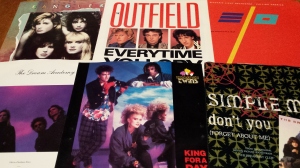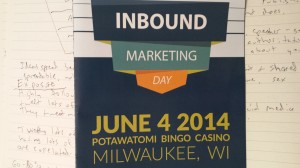 Back in the days when record albums were issued in vinyl, I used to base my decision to plop down money for the entire album on whether or not I liked the B-side of the single. My thinking was, if the B-side was good the album would be good. If the B-side was good but wasn’t on the album, the album had to be great because they had more material than they could fit on the album.
Back in the days when record albums were issued in vinyl, I used to base my decision to plop down money for the entire album on whether or not I liked the B-side of the single. My thinking was, if the B-side was good the album would be good. If the B-side was good but wasn’t on the album, the album had to be great because they had more material than they could fit on the album.
Giving More Than What’s Expected
November 11, 2014 by Leave a Comment
In both scenarios I was almost certain to go out and buy the album. If the B-side wasn’t that good or felt like a throw-away track I wouldn’t buy the album and figured that the band didn’t have enough good material to make a strong album.
Maybe my logic was a little harsh, but I wasn’t going to let them get any more of my money when they didn’t care about putting out a quality product. And for a 45 that meant two solid songs. Maybe some record labels or artists wanted to save their best material for the A-side of the singles when they didn’t realize that the B-side was an opportunity to give fans, and more importantly potential fans, a reason to love them.
When someone knocks your socks off you’ll brag to your friends about them. Today, people have thousands of friends in their social media contacts. When they share their experiences the ramifications can be huge.
Maybe I’m just jaded, but for me that bar is pretty low. It should be easy to impress, but sadly, that’s rarely the case. The companies that do though, reap the rewards. The ones that don’t won’t last. How to do it? Give more than what’s expected.
Gary Vaynerchuk talks about this a lot. He says the key to success is to care…a lot. Giving more than what’s expected is caring in it’s truest form. People don’t forget experiences, good and bad. Do your best to make it memorable by giving more than what’s expected and you can turn an okay experience into one that’s special.
Have you been impressed with a company that went above and beyond? What did they do that was different? How do you give your customers more?
Sales and Marketing Lessons from the Apple Guy
October 14, 2014 by Leave a Comment
 One of the things I love most about fall is apple season. Apples are my favorite fruit and there’s nothing like having a crisp, fresh, delicious apple. Apple season only lasts about two months, so I appreciate it when it comes around.
One of the things I love most about fall is apple season. Apples are my favorite fruit and there’s nothing like having a crisp, fresh, delicious apple. Apple season only lasts about two months, so I appreciate it when it comes around.When I was a kid, every Sunday after church in the fall, my mom would drive us to visit the Apple Guy, as he was affectionately known. His real name was Mr. Patterson.
Here are four Sales and Marketing Lessons I remember from the Apple Guy, that anyone can use:
Have a Beautiful Presentation – When you drove by, it looked like something from a Norman Rockwell painting; his car was off to the side of the road and the apples were lined up by type in baskets. He also had bags of various sizes ready-to-go. Everywhere you looked, there were apples. I remember him as a friendly man; wearing his blue jeans, plaid shirt, and baseball cap. It looked like he just came from the orchard (he did). His display was something that made you want to stop. Do you give your customers a reason to stop?
Be Helpful – He was the apple expert, but he approached customers with friendly, neighborly advice. He’d tell you what each one tasted liked (sweet, tart), if you could use them for baking, when certain types were going to be ready for harvest. McIntosh were my favorite but that wasn’t the first apple of the season. They were usually ready in mid-September. He’d say, “come back in two weeks, I’ll have the macs then.” He’d also offer a replacement. “If you like McIntosh, check out the Paula Red, or the Cortland.” Look at how you can be more helpful to your customers.
Hook ’em with a Great Offer – The Apple Guy knew how to entice his customers. He’d let you try before you buy. Not just one apple, he’d let you try all the different varieties he had. In the above example, he’d hand me both a Paula Red and a Cortland to try, so I could figure out which one I liked best. More often than not we bought more than one type of apple. What better way to get customers to fall in love with your product than to try it. He knew once you took a bite, you were hooked. What do your offers look like? Do they hook your customers?
Over-Deliver – He’d often give us more apples than would fit in the bag. He’d say those apples would be “for the road.” He’d even polish it up before he handed it to you. We always left feeling we got a great deal, and we’d have delicious apples for the week. Do you deliver or over-deliver?
Patterson Orchards is still in operation today. If you’re in the Milwaukee area you should check them out. Instead of a car on the side of the road, they have a small store that’s open each fall at the Orchard. Besides their own apples, they feature other fruits, vegetables, and bakery products from other local and regional businesses. Hand-written signs provide shoppers with information about the products, just like the Apple Guy used to do. It still feels friendly and neighborly.
I’m not sure if the Apple Guy is still around, but his orchard and his lessons in sales and marketing sure are. The lessons may be simple, but they sure are effective. Make sure you utilize them every chance you get.
3 Takeaways from Inbound Marketing Day
June 10, 2014 by Leave a Comment
 Last Wednesday I attended Inbound Marketing Day at Potawatomi Bingo Casino in Milwaukee. What a great mix of local and national inbound marketing experts. I heard great presentations about content, landing page optimization, buyer personas, video strategy, and a lot more.
Last Wednesday I attended Inbound Marketing Day at Potawatomi Bingo Casino in Milwaukee. What a great mix of local and national inbound marketing experts. I heard great presentations about content, landing page optimization, buyer personas, video strategy, and a lot more.
Many of these ideas not only work in marketing but in daily interactions as well, whether business or personal.
Here are three key takeaways:
Dan Zarrella from HubSpot: How does your content help your fans build their reputation?
My two cents: The job of your content, or your company, is to help your customers look good to their customers. Content shouldn’t be designed to help you look good, although by helping them solve their problems you will.
What are your customers’ pain-points? What content can you provide that helps alleviate those pain-points? If you can make your customers look like heroes, you’ll end up a winner.
Jeff Coon from Stream Creative: What makes you look like a rock star? Have signals in place to alert others. What are the symbols of trust in your industry? Add them to your content, your name, your brand, etc. If there are certifications, partnerships, or logos that show you know what you’re doing, you need to highlight them.
My two cents: What makes you stand out? There are certain things that give you instant credibility. For me, it’s having MBA behind my name. For your business, it could be “Best Places to Work” or a Better Business Bureau sticker on your front door. It could be words like Author, or Speaker. These words conjure up an image of you in the eyes of people that don’t know you. Use them to your advantage.
Ezra Fishman from Wistia: Think in terms of the Trust Bank. You are either building trust or spending trust. Using video is a great way to build trust. If you teach someone something in a video, it allows you to bring the human element in.
My two cents: We should always be giving to people without the thought of getting something in return. This builds trust. Then, when we truly need help from our customers, community, or our friends, we have enough trust in the bank to be fairly certain that they will help us when we ask.
Be yourself. Allow your personality to shine through. People like doing business with people, not brands. If they trust you, they’ll trust your brand.
Do you see yourself using any of the three ideas from Inbound Marketing Day? Let me know which ones you use. I’d love to know what success you have with them.
Who Have You Helped Today?
November 5, 2013 by Leave a Comment
 Learning how to give instead of trying to get, changed how I approached sales, customer service, and life.
Learning how to give instead of trying to get, changed how I approached sales, customer service, and life.At one point, early in my career, I worked in sales for a large telecommunications company. I struggled constantly to meet my monthly sales objective. I came close a few times, but never made 100% of my objective. My job was held over my head every month. The message was – “sell or you could find yourself out of a job.” Talk about stress.
Then one month I finally made it – 100.2%. Time to celebrate. But, the next day I checked, I was only at 99.9%. I went through my orders and found that someone had gone in and put their sales codes on one of my orders. When I told my manager all she told me was, “You need to pay more attention to your orders.” She didn’t even try to help me rectify the problem, and stealing sales was a huge problem where I worked.
This episode left me bitter. Why try to meet the sales goal when it’s going to be stolen from me anyway? The company is going to say I am a bad employee (anything less than a 100% was “does not meet expectations.”) Throw in a daily dose of customers yelling at you and I was at the bottom. I went through months of the absolutely worst days I had working in that call center.
Finally, I made a decision. Since I couldn’t find any satisfaction in the job doing it the company way, I would try things differently. I love helping people. It makes me feel good. I was raised to think of others. I decided if I could help one person each day, then it would be a successful day in my books, regardless of how much I sold. If I was going to get fired, at least I was going to enjoy the process. I essentially ignored my sales objective. I forgot about it, didn’t care, eliminated it from my radar. I wasn’t going to let my sales, or lack thereof, define whether I had a good day or not.
So, I started each day with two objectives. The first, was to help one person that day. I would literally say to myself before logging in to take my first call, “Who am I going to help today?” I knew somebody out there really needed my help, and if I took their call I would do everything in my power to help them.
The second thing I said to myself each morning was, “What’s going to happen to me today, that’s never happened to me before?” This was freeing. I knew I’d get a nasty call that day, a problem that would otherwise ruin my day, but I wasn’t going to let it affect me. I built it into my day. I anticipated it. I looked at it as a learning experience.
The funny things is, once I started to ignore my sales numbers and focus on helping my customers, my sales took off. I went from making 90% of my monthly sales to an average of 120%. The highest month I had was 153% of my objective! And, after a while I was helping more than one person a day. Go figure!
And, because I didn’t mind receiving the “problem” call, I looked at it as a way to learn and also help, I became the guy that knew how to solve problems. If someone ran into some mess they’d be referred to me since I had probably run into it at some point. I kept records of the problems I encountered and how to fix them. I ended up becoming a team leader; writing and presenting training, handling difficult calls, and helping coach others.
I also sat in on a few sales meetings because of my high sales. You know those meetings where they want to know what you do and then roll it out to the rest of the call center? Yeah, those. When I was asked for my opinion on how to increase sales I said, “Get rid of the sales objective.” The manager looked at me and blurted out, “that will never happen” and ignored me for the rest of the meeting. Their loss, I thought.
There’s been a lot of research lately to back up why looking at helping others is a good plan to have. One fantastic book that explores this is Adam Grant’s “Give and Take.” It shows why giving is the best way to achieve your own success. It’s worked for me. What is your experience?
Follow Me!